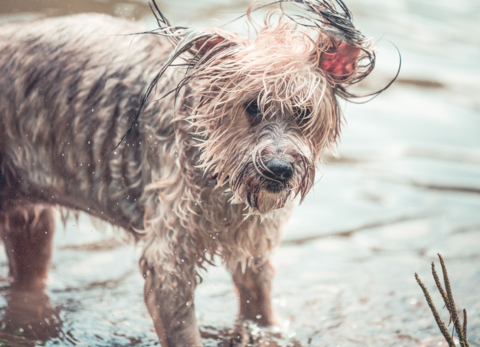
As much as we love them, dogs with separation anxiety can be challenging to live with. Many of them can be destructive, and dealing with a dog who gets stressed out every time you leave the house can also be stressful for you! However, as overwhelming as it can feel, separation anxiety is a common issue many dogs (and even cats) experience.
Learning how to treat a dog with separation anxiety can help return your household to a calm state and keep your relationship with your pet strong, healthy, and, most of all, positive for both of you.
What Is Separation Anxiety?
Treating a dog with separation anxiety starts with a basic understanding of the condition and its symptoms.
Separation anxiety occurs when a dog becomes anxious about being separated from the human guardians with whom they’ve formed a bond. Dogs with separation anxiety show their distress with physical and behavioral manifestations; we’ll discuss both later in this article.
Researchers estimate that up to 14 percent of dogs deal with separation anxiety, although the severity of their symptoms can vary greatly.
Why Do Dogs Develop Separation Anxiety?
There’s no black-and-white answer for why a dog might develop separation anxiety. However, anecdotal evidence has shown that dogs from a shelter environment are more likely to deal with at least some separation anxiety than those a single family has raised since puppyhood.
However, research has shown that some common situations trigger separation anxiety in the majority of dogs:
- A change of family – Being left at a shelter or adopted by a new family (no matter their age) can be stressful enough to trigger separation anxiety, even if the change of family is positive.
- A change in schedule – Any change or lack of predictability in a dog’s schedule can make them more anxious. Examples include their pet parent returning to work after an extended leave or no longer being able to work from home (this is a trigger many of us are familiar with since the end of COVID restrictions).
- A change in location – Even if it means moving into a new home with more space or a fenced-in backyard to run around in, changing location can be stressful enough to trigger separation anxiety in many dogs.
- A change in household members – Any change in the household members, like a death, divorce, or new baby, can cause a dog to become more attached to their “stable” family member and lead to separation anxiety.
- A previous traumatic event – Dogs who have experienced a traumatic event, especially when they were alone, are more likely to develop anxiety over being separated from their “safe” human.
Studies have also shown that male dogs have more issues with separation anxiety than female dogs. Lack of socialization (especially between the ages of five to 10 months) and being removed from their mother too soon can also increase the risk of developing attachment issues.
Recent research has narrowed it down even further and found four primary triggers for distress in a dog separated from their human — the desire to get away from something inside the house, wanting to get something outside the home, boredom, or a reaction to an unexpected noise or event.
Understanding what is driving your dog’s fear can be massively helpful in treating it.
Physical Symptoms of Separation Anxiety
One way to recognize that your dog is dealing with separation anxiety is by looking at their physical symptoms.
Anxious dogs tend to become acutely aware of your routines, which means they notice small changes in your behavior before you leave that you may not even be aware of. When they recognize your departure cues (or even think that you might be getting ready to leave), you’ll notice separation anxiety’s physical symptoms.
For example, dogs with separation anxiety will often start to follow you around while they pant or even drool. They may even use vocalization to communicate their feelings — whining, barking, or even howling (although many will wait until you’ve actually left the house to turn the volume up).
When you get back to the house, you’re also likely to find physical signs that your dog has continued to be in distress while you’re gone. Some anxious dogs urinate or defecate in the house. Others leave puddles of saliva or the chewed-up remnants of shoes, clothes, or even furniture in their wake (be careful, as these can be choking or obstruction hazards).
Every dog with separation anxiety is unique and expresses their stress level differently, so ensure you’re attuned to what your dog is trying to tell you.





